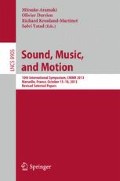Abstract
Audio feature estimation involves measuring key characteristics from audio. This paper demonstrates the improvement of a feature estimation method using an auditory memory model with rehearsal included. The auditory memory model is achieved using onset detection to identify new audio components for insertion into the auditory memory, and an algorithm that then combines the characteristics of the current interval with those of the audio components in the auditory memory. The auditory memory model mimics the storing, retrieval and forgetting processes of the short-term memory, and in this work the rehearsal as well. The feature estimation using the auditory memory model has been successfully applied to the estimation of sensory dissonance, and the characteristics of the memory model has been shown to be of interest in music categorization. The rehearsal step in the memory model is an important step in the understanding of the model. In addition, the dissonance estimation correlation with human ratings is tested with or without including rehearsal in the auditory memory model.
Access this chapter
Tax calculation will be finalised at checkout
Purchases are for personal use only
References
Anderson, J.R., Lebiere, C.: Atomic Components of Thought. LEA, Hillsdale (1998)
Atkinson, R.C., Shiffrin, R.M.: Human memory: a proposed system and its control processes. In: Spence, K.W., Spence, J.T. (eds.) The Psychology of Learning and Motivation, vol. 2, pp. 89–195. Academic Press, New York (1968)
Baddeley, A.D., Hitch, G.: Working memory. In: Bower, G.H. (ed.) The Psychology of Learning and Motivation: Advances in Research and Theory, vol. 8, pp. 47–89. Academic Press, New York (1974)
Cowan, N.: The magical number 4 in short-term memory: a reconsideration of mental storage capacity. Behav. Brain Sci. 24, 87–185 (2000)
Gross, R.: Psychology: the science of mind and behaviour. Hodder Arnold Publication, London (2005)
Hjortkjær, J.: Toward a cognitive theory of musical tension. Ph.D. thesis, University of Copenhagen (2011)
Jensen, K.: On the use of memory models in audio features. In: Symposium of Frontiers of Research on Speech and Computer Music Modeling and retrieval (FRSM/CMMR - 2011), pp. 100–107. Bhubaneswar, India, 9–12 Mar 2011
Jensen, Kristoffer: Music genre classification using an auditory memory model. In: Ystad, Sølvi, Aramaki, Mitsuko, Kronland-Martinet, Richard, Jensen, Kristoffer, Mohanty, Sanghamitra (eds.) CMMR and FRSM 2011. LNCS, vol. 7172, pp. 79–88. Springer, Heidelberg (2012)
Jensen, K., Hjortkjær, J.: An improved dissonance measure using auditory memory. J. Acoust. Soc. Am. 60(5), 350–354 (2012)
Jensen, K.: Multiple scale music segmentation using rhythm, timbre and harmony. EURASIP Journal on Applied Signal Processing, Special issue on Music Information Retrieval Based on Signal Processing 2007, 11 (2007)
Kameoka, A., Kurivagawa, M.: Consonance theory part 1-2. J. Acoust. Soc. Am. 45(6), 1451–1469 (1969)
Miller, G.A.: The magical number seven plus or minus two: some limits on our capacity for processing information. Psychol. Rev. 63(2), 81–97 (1956)
Plomp, R., Levelt, W.J.M.: Tonal consonance and critical bandwidth. J. Acoust. Soc. Am. 38(4), 548–560 (1965)
Radvansky, G.: Human Memory. Allyn and Bacon, Boston (2005)
Sethares, W.: Local consonance and the relationship between timbre and scale. J. Acoust. Soc. Am. 94(3), 1218–1228 (1993)
Snyder, B.: Music and Memory. An Introduction. The MIT Press, Cambridge (2000)
Author information
Authors and Affiliations
Corresponding author
Editor information
Editors and Affiliations
Rights and permissions
Copyright information
© 2014 Springer International Publishing Switzerland
About this paper
Cite this paper
Jensen, K. (2014). Influence of Rehearsal in an Auditory Memory Model for Audio Feature Estimation. In: Aramaki, M., Derrien, O., Kronland-Martinet, R., Ystad, S. (eds) Sound, Music, and Motion. CMMR 2013. Lecture Notes in Computer Science(), vol 8905. Springer, Cham. https://doi.org/10.1007/978-3-319-12976-1_35
Download citation
DOI: https://doi.org/10.1007/978-3-319-12976-1_35
Published:
Publisher Name: Springer, Cham
Print ISBN: 978-3-319-12975-4
Online ISBN: 978-3-319-12976-1
eBook Packages: Computer ScienceComputer Science (R0)

